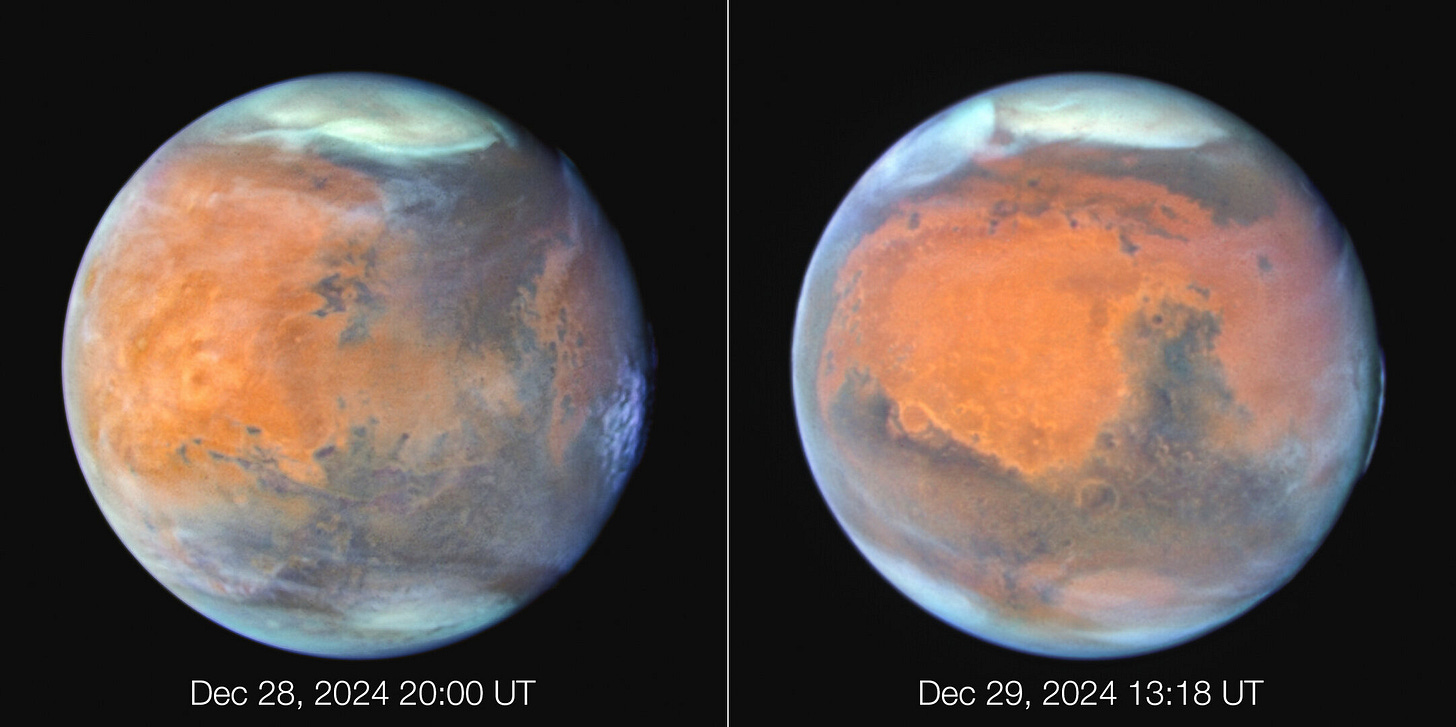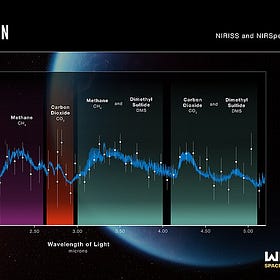The Week in Space and Physics: The Next Helicopters on Mars
On the future of flight on Mars, the return of a Kosmos-482, hints of a planet beyond Neptune, and lift-off for Project Kuiper.

The first mechanical flight on Mars took place on a Monday in April 2021. It was a short flight. The helicopter, named Ingenuity, flew for about forty seconds and spent the whole time hovering just a few metres above the Martian terrain. But it proved the principle, and afterwards Ingenuity went on to fly through Mars’ thin air another seventy times, traversing a distance of more than seventeen kilometres in total.
Sadly, the helicopter is no longer flying. An accident early last year damaged its rotor blades, and since then it has been abandoned to gather dust on the Martian surface. Yet the success of Ingenuity has raised the chances of future helicopter flights on Mars, and allowed researchers to begin imagining what an aerial exploration of the planet might look like.
One tempting target, as a recent study outlined, would be the vast canyons of the Valles Marineris. From orbit this region looks like an enormous scar on the planet, one stretching for thousands of miles across the equator of Mars. It is in reality a grand canyon system, one far deeper and more ancient than the Grand Canyon of Arizona, and, indeed, more impressive than any other found in the solar system.
We do not know how it formed. It could be a tectonic crack in Mars’ surface, a relic of a time when Mars had violent volcanic activity and when its crust began to rift and break in a way not unlike that seen in some places on Earth today. Later on, deep lakes might have filled the canyons, and they seem to have sometimes spilled in immense floods, forming eroded rocks and bizarre and unique geological structures.
Whatever its history, Valles Marineris would be a place worth exploring. Unfortunately, landing rovers or probes there is difficult. The terrain is harsh and steep, and rovers would struggle to keep their grip on the surface. NASA would never risk sending a billion-dollar rover only to see it fall into the depths of a canyon.
But helicopters could work. A swarm of them could be sent to fly through the canyons, each of them sending back footage of a fantastic landscape. They could even fly through lava tunnels and into cave systems, thus reaching places no rover would dare venture into. Such a mission, if it ever comes to pass, would be a milestone in Martian exploration.
The question, though, is whether it will happen. NASA is currently facing big budget cuts, and no new American rovers are being planned for Mars. Neither are any follow-ups to Ingenuity being seriously considered, no matter how good an idea one would be. Instead it seems possible that China or India might seize the opportunity.
Indeed, in March China outlined ambitious plans to explore the solar system; plans that include a new rover for Mars and the establishment of a long-term research base on the surface. There is a reasonable chance, then, that the next helicopters to fly on the red planet will be made in China.
The Return of Kosmos-482
In 1972, the Soviet Union launched a Venera probe towards Venus. Sadly, it didn’t work out: instead of propelling the spacecraft towards Venus, the rocket’s upper stage failed and the probe was left in a high orbit around the Earth. With no options for rescue, the Soviets designated it as satellite Kosmos-482 and then abandoned it in orbit.
Of course, things abandoned in orbit do eventually tend to return to Earth. Kosmos-482 is no exception: skywatchers have tracked its gradual descent over the past half century, and predicted on several occasions a re-entry date in the 2020s. That long-awaited moment now seems to be upon us, with the latest predictions estimating it will plunge towards the surface on May 11.
For most spacecraft that would be the end. Few survive the stresses and temperatures of a high-speed re-entry, and so they mostly burn up well before reaching the Earth’s surface. Yet Kosmos-482 is not a normal satellite. It was designed to survive a fall through the harsh atmosphere of Venus, and it therefore seems likely to make it through Earth’s much gentler layers of oxygen and nitrogen relatively unscathed.
But it is uncertain whether we will be able to recover anything. For one thing the probe would need parachutes to slow itself down, and no one knows if the fifty year old devices on the spacecraft still work. Indeed, some images suggest the parachutes have already deployed in orbit, in which case the shock of re-entry will probably rip them away.
Part of the mystery lies in the secretive nature of the Soviet space program. When two small pieces of the same spacecraft re-entered and fell on New Zealand shortly after the initial failure, the Soviets denied all knowledge of the probe. Neither has the design of the probe, nor any of its mechanisms, ever been released.
But we can make some guesses. Without the parachutes, models suggest the probe will hit the ground at over two hundred kilometres per hour. That – whether it hits land or water – will certainly destroy it. As usual, the risks of someone getting hit are low, but not quite zero. There is, indeed, a reasonable chance someone out there might soon find a chunk of this fifty-three year old explorer.
The Hunt for the Earth’s Final Sibling
Does our solar system have another planet hidden in the outer darkness? At the moment the realm of the planets ends at Neptune, and though astronomers have discovered plenty of dwarf planets beyond, they have not yet found any large enough to meet the stringent definition of a planet.
That said, there are a few hints that another world could lie out there, well beyond the orbit of Pluto. Some astronomers studying the outer dwarf planets reckon there is a pattern in their motions, and that this might be because an unknown planet is exerting a steady pull on them. Others, of course, think they are just seeing noise or side-effects of our observational techniques, and that the mooted signs of a planet are nonsense.
If this world exists, it will be dark and hard to see. But in a recent study, a team of researchers compared surveys of the sky taken in the 1980s and mid-2000s. They argue that the planet, if it exists, might have shown up in these surveys. And since planets move over time, it should be possible to see the planet as an object that has moved slightly between the dates of the two surveys.
The researchers claim they found one possible match in the data. But whether this is really a planet is hard to tell. More observations will be needed, and so confirming or ruling out the possibility will take time. But it does seem, at least for now, that the possibility of finding another member of the solar system’s family remains open.
Project Kuiper Reaches Orbit
Amazon last week launched the first twenty-seven operational satellites of its Kuiper constellation. All were lofted into orbit by an Atlas V rocket, and they represent the first batch of the more than three thousand satellites that will be needed to complete the project.
The American company hopes the Kuiper constellation will offer a rival to SpaceX’s Starlink service. That system is already used by millions of customers and estimates reckon it is highly profitable: SpaceX may make more than ten billion dollars from it this year alone.
Of course, SpaceX benefits from owning and flying their own rockets, which allows them to put satellites in orbit for a remarkably low price. Amazon, despite their close relationship with Blue Origin, does not enjoy such low prices. But they may be hoping to bundle Kuiper services with their other offerings, which already include a network of ground stations integrated with Amazon’s cloud computing service.
Read More
Hubble: Thirty-Five Years of Stunning Photography
First, I’d just like to share a call from Dr. Larry Krumenaker to help give the recently discovered ashes of the science writer Willy Ley a well-suited memorial. You can find more details and ideas o…
The James Webb Still Hasn’t Found Life on K2-18b
A year ago, rumours surfaced of an impending discovery of alien life. They focused on the planet K2-18b, an intriguing wor…




People have been searching for "Planet X" for a long time. The pity about demoting Pluto is that the "X" could have stood for 10. (And, yeah, I'm among those grumpy about Pluto's demotion. I accept the new definition but still think Pluto should have been grandfathered.)